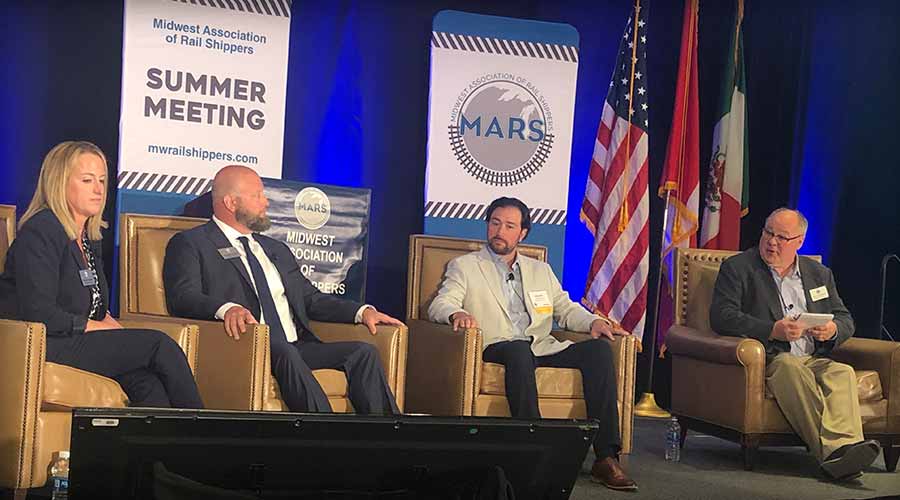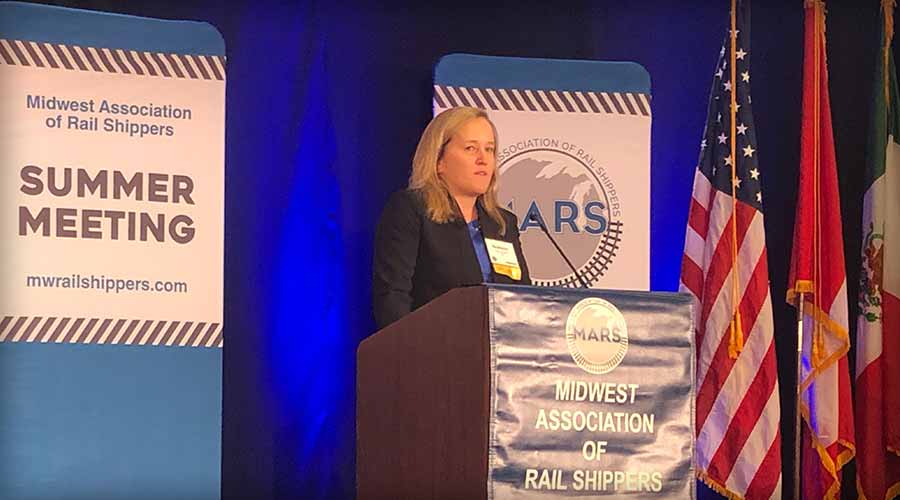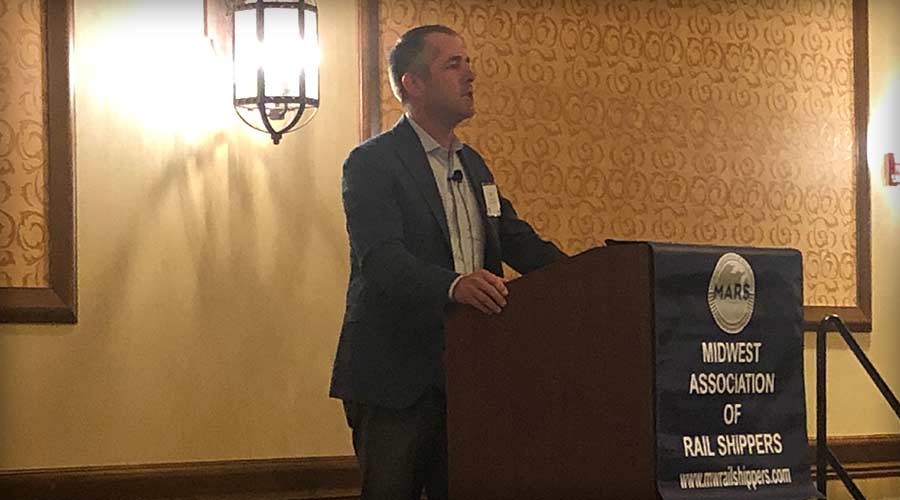Takeaways and tidbits from MARS summer meeting in Wisconsin
7/14/2023
By Jeff Stagl, Managing Editor
The Midwest Association of Rail Shippers (MARS) held the business meeting portion of its 2023 summer conference on July 11 at the Grand Geneva Resort in Lake Geneva, Wisconsin.
The gathering, which drew several hundred attendees, was notable for two reasons. No. 1: It was the organization’s 260th meeting since it was formed 99 years ago. No. 2: It featured eight intriguing presentations by executives from Class Is, shippers and other rail industry stakeholders.
The presentations touched on a number of common themes, including technology, sustainability, rail service and the rail customer experience.
Following are snippets from five of the presentations. A separate RailPrime item that summarizes the informative keynote address provided by Canadian Pacific Kansas City Executive Vice President and Chief Marketing Officer John Brooks will be posted next week.
Panel
Supply Chain Success with Rail
Moderated by Eric Jakubowski, the VP/chief commercial officer for Anacostia Rail Holdings Co. and executive committee member for MARS
Panelists: Monica Freeman, director of rail transportation for CHS Inc., Doug Grewe, transportation manager for Packaging Corp. of America; and Joe Monfredi, director of logistics services for U.S. Steel
In response to a question from Jakubowski about how each panelist sizes up the current economy, Grewe said he was fairly optimistic about its trajectory.
“Like in other industries, some segments are up and some are down,” Grewe said.
Joked Jakubowski, referring to Amazon Prime Days on July 11 and 12: “It’s Amazon day, so that should help your business.”
Freeman said CHS — a cooperative owned by U.S. farmers and others — is expecting a good grain harvest. But that then begs the question how railroads will react to heavier volumes given their recent service issues, she said.
“We have seen improvements in transit time. How will it be when it gets busier? We are hesitant to say everything is great [with rail] after some service problems,” Freeman said.
For Monfredi, there are both strengths and softness in various markets. U.S. Steel will benefit from a large construction project in Arkansas, he added.
Jakubowski also asked the panelists what their desired changes would be to the shipment data currently provided by railroads.
Freeman seeks better first- and last-mile data. But it needs to be more accurate and synched “without exposing a company’s private information,” she said.
Grewe desires more common and normalized metrics across all the Class Is.
“Then we can create our own reports,” he said. “We can talk apples to apples to drive change.”
Meanwhile, Monfredi expressed the need for better car-order filling data on the manifest train side.
Presentation
Thriving Through Adaptability
Speaker: Kevin Murray, VP of supply chain for rail shipper Red Gold
A privately owned manufacturer of canned tomato products, Red Gold is a small rail shipper. Murray began his presentation by unveiling an inflatable Bozo the Clown punching-bag toy, which he believes has proven its resilience by remaining virtually unchanged since the 1950s.
“Short lines are the clown,” Murray joked while punching the toy. “They are really good at getting punched.”
 Red Gold VP of Supply Chain Kevin Murray talked about the importance of being both resilient and adaptable to better navigate today’s supply chains. Jeff Stagl
Red Gold VP of Supply Chain Kevin Murray talked about the importance of being both resilient and adaptable to better navigate today’s supply chains. Jeff Stagl In a more serious vein, he said it’s important for shippers to figure out, work with and partner with railroads to prompt ideal service.
“Resilience without adaptability is unsustainable,” said Murray, adding that valuable lessons can be learned by railroads and their customers during a supply-chain crisis.
His warning to the audience was unusual, but fitting: “Don’t be a camel.” Camels are hardworking and loyal animals in the desert, yet they have an “Achilles heel” that can break a smooth-going chain in the sand — they have enormous endurance without ever showing any evidence of fatigue, said Murray.
“Once a camel goes down, it doesn’t get up,” he said.
The important thing for railroads and shippers is to work though problems without causing breaks in the supply chain, Murray stressed.
Presentation
Expansion and Sustainability
Speaker: Shannon Baker, head of customer solutions for CSX
For a number of years, CSX has offered shippers an online carbon calculator that estimates how much carbon-dioxide emissions they can save by moving their goods by rail. The tool has been beneficial for driving carload business, and next year CSX plans to introduce an intermodal carbon calculator, Baker said.
The Class I also has enhanced its online Select Sites tool that’s designed to help shippers locate the best rail-served sites for a new development or plant expansion. Recent upgrades have increased the number of certified-site categories to four: platinum, gold, silver and bronze. Platinum sites have undergone the most detailed and rigorous certification process to ensure a high level of due diligence, Baker said.
 CSX is analyzing biofuel-powered locomotives and the use of liquified natural gas as a motive-power fuel, said Shannon Baker, the head of customer solutions. Jeff Stagl
CSX is analyzing biofuel-powered locomotives and the use of liquified natural gas as a motive-power fuel, said Shannon Baker, the head of customer solutions. Jeff Stagl“It’s an easy way for [shippers] to determine what their needs are,” she said.
Baker also provided a number of examples as to how CSX is striving to boost its sustainability efforts. The railroad is trying to optimize train-handling techniques, increase the use of distributed power and explore more alternative fuels.
For example, the railroad is analyzing biofuel-powered locomotives and the use of liquified natural gas as a motive-power fuel.
“We have a team that’s 100% focused on alternative fuels,” Baker said.
Presentation
The STB’s Current and Future Approach to Rail Regulation
Speaker: Patrick Fuchs, member of Surface Transportation Board
The STB of late has strived to address two limitations that are impacting its ability to ideally regulate the rail industry: the quality of disseminated information and myopia, Fuchs said.
The board is not actively involved in the day-to-day operations of railroads and employs a staff of fewer than 150, so information compiling and sharing is a challenge, he said. The STB recently formed a new working group that aims to have a broader informational impact on railroads and the public.
In terms of myopia, the board is trying to better deal with the things it can’t control and distance itself from short-sightedness.
“We need to take a more long view,” said Fuchs.
For example, the STB should place more value on single-line hauls, such as what the recently formed Canadian Pacific Kansas City can offer, he said.
Keynote
Union Pacific Railroad Update
Speaker: Dan McLaughlin, UP’s assistant VP of marketing and sales operations
McLaughlin reviewed the actions UP is taking to leverage innovation and sustainability as growth drivers.
The railroad needs to spur growth since its traffic was down 2% year over year in 2023’s first half, with forest products carloads down 15% and intermodal volume down 5%. However, that intermodal traffic outcome wasn’t too discouraging because the entire intermodal market was down by a percentage in the teens, McLaughlin stressed.
While UP is trying to make better use of latent capacity, expand its network reach and work with subsidiary Loup Logistics to increase transload opportunities, what the railroad can accomplish in advancing innovation might have a bigger influence on growth potential, McLaughlin believes.
 During his luncheon keynote, UP’s Dan McLaughlin described how providing more application programming interfaces can make it easier for customers to conduct business with the railroad. Jeff Stagl
During his luncheon keynote, UP’s Dan McLaughlin described how providing more application programming interfaces can make it easier for customers to conduct business with the railroad. Jeff StaglUP continues to employ Precision Train Builder to simulate train operations over hundreds of miles of track and more quickly determine how many locomotives are needed and where to place the locomotives and cars on a train to boost efficiency; and DigiCrew mobile work order devices in the field to improve communications.
The Class I also is trying to implement more application programming interfaces (APIs) to make it easier for customers to perform business functions with the railroad, McLaughlin said. For example, one customer now is saving two hours that were spent every day to trace its cars online by instead using an API, he said.
In addition, UP is advancing its participation in RailPulse, a joint venture that aims to develop, broaden and accelerate the use of GPS and other telematics technologies on freight cars in North America. About 150 cars should be equipped with telematics by year’s end, McLaughlin said.
“We will test sensors in a live operating environment, and identify practical use cases to test,” he said.
Sustainability — or decarbonizing UP’s operations — is a big emphasis now, too, McLaughlin said. To that end, the railroad is analyzing locomotives powered by batteries, hydrogen or renewable fuels; modernizing locomotives with Wabtec Corp.; employing more biofuels; pursuing renewable electricity and solar farms; and installing more LED lighting.
“We will be using up to 6% in renewable fuels this year,” McLaughlin said.
Moreover, UP is exploring the creation of a “green lane” with any interested customer that would leverage a number of technologies and processes to achieve zero carbon emissions in a move.


